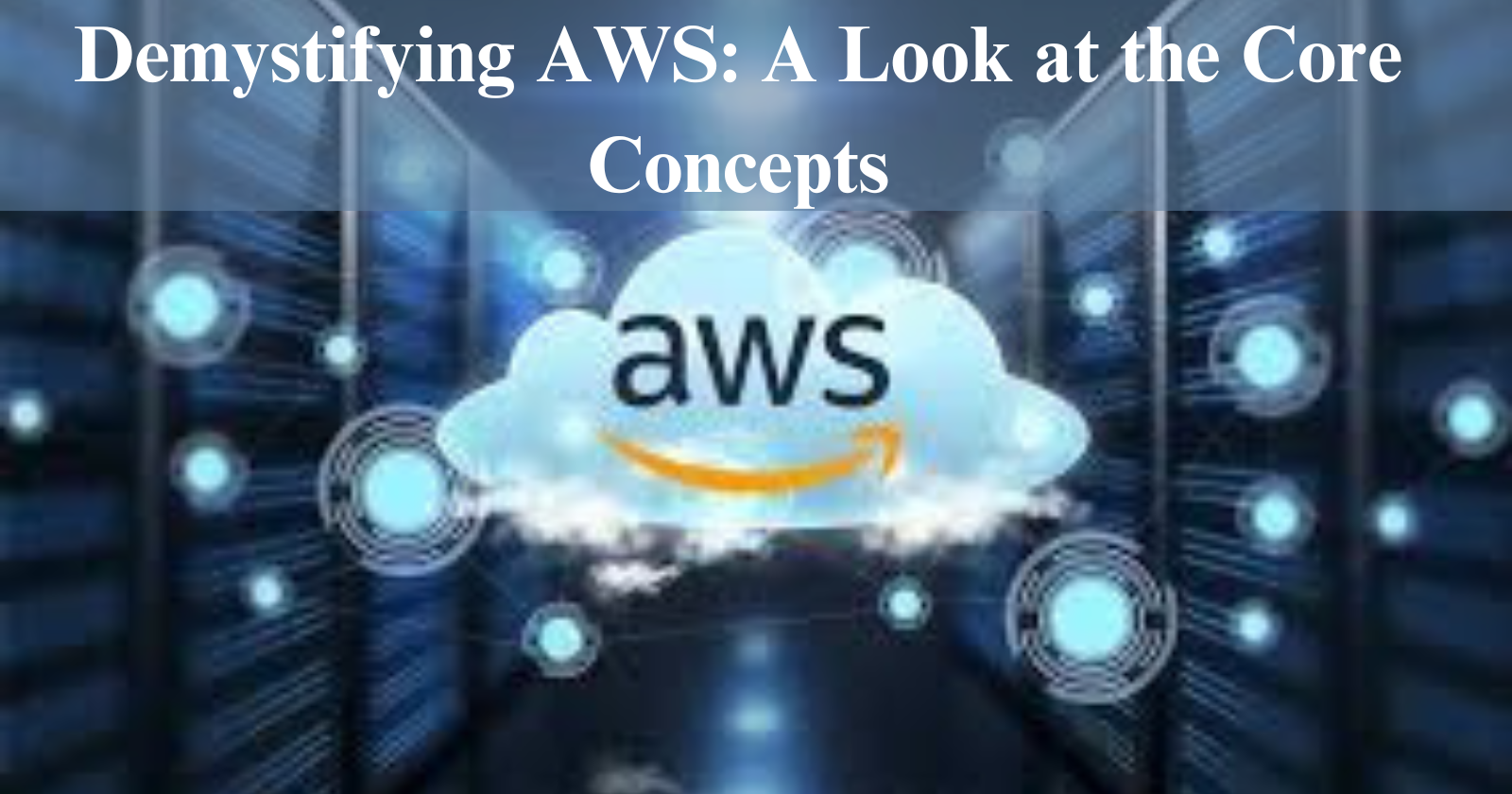Demystifying AWS: A Look at the Core Concepts
 kanika chauhan
kanika chauhan
In today’s technology-driven world, Amazon Web Services (AWS) has become a cornerstone of cloud computing, providing scalable and flexible solutions to meet diverse business needs. For newcomers, AWS might appear complex with its vast array of services and features. However, understanding the core concepts can simplify your journey into the world of AWS. This blog will demystify AWS by exploring its fundamental components and how they come together to form a powerful cloud computing platform.
1. What is AWS?
Amazon Web Services (AWS) is a comprehensive cloud computing platform offered by Amazon. It provides a wide range of cloud services, including computing power, storage, databases, and networking. AWS enables businesses and individuals to run applications and store data on virtual servers rather than physical hardware. This model allows for greater scalability, flexibility, and cost-efficiency.
Key Benefits:
Scalability: Easily scale resources up or down based on demand.
Cost-Efficiency: Pay only for the resources you use with no upfront costs.
Global Reach: Access services from data centers around the world.
2. Core AWS Services
To effectively utilize AWS, it’s essential to understand its core services, which form the foundation of many AWS solutions. Here are some of the key services:
Elastic Compute Cloud (EC2)
EC2 is a fundamental service that provides scalable virtual servers known as instances. These instances can be used to run applications, host websites, or perform data processing tasks. EC2 offers various instance types optimized for different use cases, such as compute-intensive tasks or memory-heavy applications. It allows users to scale resources dynamically and pay only for the compute capacity they use.
Key Features:
Scalability: Automatically adjust the number of instances based on workload.
Variety: Choose from a range of instance types and sizes.
Elasticity: Start, stop, and resize instances as needed.
Simple Storage Service (S3)
S3 is an object storage service designed for storing and retrieving any amount of data. It’s commonly used for backup, archiving, and serving static content like images and videos. S3 organizes data into buckets and provides high durability and availability, making it a reliable choice for storing critical data.
Key Features:
Durability: Designed for 99.999999999% durability.
Scalability: Automatically scales to handle growing data needs.
Access Control: Manage access to your data with fine-grained permissions.
Relational Database Service (RDS)
RDS simplifies the setup, operation, and scaling of relational databases. It supports several database engines, including MySQL, PostgreSQL, Oracle, and SQL Server. RDS automates tasks such as backups, patching, and scaling, allowing you to focus on application development rather than database management.
Key Features:
Automated Backups: Regular backups and point-in-time recovery.
Scaling: Easily scale database instances and storage.
High Availability: Options for Multi-AZ deployments and read replicas.
Identity and Access Management (IAM)
IAM allows you to manage user access and permissions within your AWS environment. With IAM, you can create and manage users, groups, and roles, and assign policies to control what actions they can perform on your AWS resources. IAM ensures secure and granular access control, helping you protect your AWS environment.
Key Features:
Granular Permissions: Control access at a detailed level.
Multi-Factor Authentication (MFA): Enhance security with MFA.
Policy Management: Define and manage permissions using policies.
Virtual Private Cloud (VPC)
VPC lets you create a virtual network within AWS, providing control over your IP address range, subnets, route tables, and network gateways. VPC allows you to isolate your resources and control traffic between them, enhancing security and enabling network configurations tailored to your needs.
Key Features:
Custom Networking: Define your own network architecture.
Security: Use security groups and network ACLs to manage access.
Connectivity: Connect your VPC to on-premises networks or other VPCs.
CloudFormation
CloudFormation is a service that enables you to define and provision AWS infrastructure using code. With CloudFormation, you create templates in JSON or YAML that describe the AWS resources you need. This approach allows for automated, repeatable infrastructure deployments and version control.
Key Features:
Infrastructure as Code: Define and manage infrastructure through templates.
Automated Deployment: Provision and configure resources automatically.
Version Control: Track changes to your infrastructure templates.
Lambda
AWS Lambda is a serverless compute service that lets you run code in response to events without managing servers. You write functions that are triggered by events from other AWS services or external sources. Lambda automatically scales to handle incoming requests, and you pay only for the compute time you consume.
Key Features:
Serverless: No need to manage servers or infrastructure.
Event-Driven: Execute code in response to events.
Automatic Scaling: Scale based on the number of incoming requests.
CloudWatch
CloudWatch provides monitoring and management capabilities for AWS resources and applications. It collects metrics, logs, and events, allowing you to monitor performance, set alarms, and automate responses to changes in your AWS environment. CloudWatch helps you gain insights into system health and performance.
Key Features:
Metrics Collection: Monitor and visualize performance metrics.
Alarms: Set up alerts for specific conditions or thresholds.
Logs Management: Aggregate and analyze log data for troubleshooting.
3. AWS Pricing and Cost Management
AWS uses a pay-as-you-go pricing model, meaning you pay only for the resources you use. This model provides flexibility and cost efficiency. To manage costs effectively:
Understand Pricing Models: Familiarize yourself with pricing for different services, such as on-demand, reserved, and spot instances.
Use the AWS Pricing Calculator: Estimate costs for your AWS resources using the AWS Pricing Calculator.
Monitor Spending: Use AWS Cost Explorer and billing alerts to track and manage your expenses.
4. Getting Started with AWS
To begin your AWS journey:
Create an AWS Account: Sign up for an AWS account and explore the free tier to get hands-on experience with basic services.
Explore the AWS Management Console: Familiarize yourself with the web-based interface for managing AWS resources.
Leverage AWS Training: Take advantage of AWS’s online training resources and certification programs to deepen your knowledge.
Experiment and Learn: Use AWS’s documentation, tutorials, and hands-on labs to practice and apply what you’ve learned.
Conclusion
AWS is a powerful and versatile cloud computing platform that can transform how you manage and deploy technology. By understanding the core concepts and services—such as EC2, S3, RDS, IAM, VPC, CloudFormation, Lambda, and CloudWatch—you can begin to navigate AWS with confidence. As you continue to explore and experiment, you’ll uncover even more capabilities and use cases, ultimately harnessing the full potential of AWS for your personal and professional needs. To deepen your expertise and gain a competitive edge, consider enrolling in the Best AWS Training Institute in Faridabad, Noida, Greater Noida, Delhi, Gurgaon and other cities in India.
Subscribe to my newsletter
Read articles from kanika chauhan directly inside your inbox. Subscribe to the newsletter, and don't miss out.
Written by
